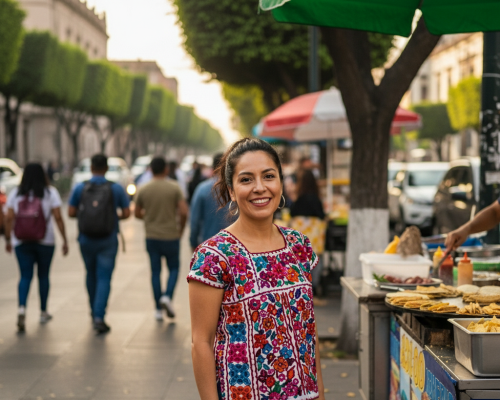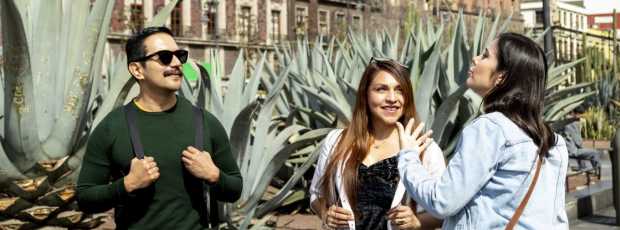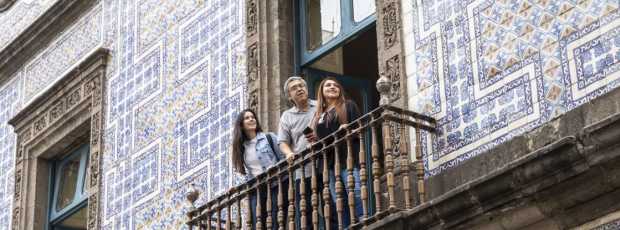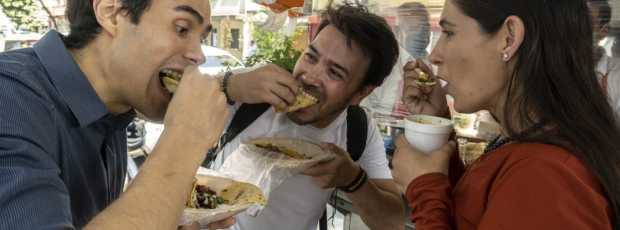Table Of Contents
- Welcome to My Mexico City
- Must-See Attractions That Define Mexico City
- Overrated Spots and Their Better Alternatives
- Authentic Eats That Define Mexico City
- Mexico City's Café and Dessert Culture
- Shopping Experiences That Capture Mexico City's Character
- Neighborhood Explorations: Mexico City's Diverse Districts
- Things to Do by Interest: Tailored Mexico City Experiences
- Cultural and Historical Insights: Understanding Mexico City's Soul
- Frequently Asked Questions About Mexico City
- Conclusion: Embracing Mexico City's Endless Possibilities
Welcome to My Mexico City
I've walked these streets for thirty-four years, and every corner still surprises me. Born and raised in the sprawling embrace of Ciudad de México, I've watched neighborhoods transform, tasted countless tacos, and danced to mariachi songs echoing through Plaza Garibaldi until dawn.
My Mexico City isn't just a destination; it's home, with all its beautiful contradictions.
When people ask me about things to do in Mexico City, I don't just think about monuments and museums.
I think about the smell of fresh tortillas drifting from a corner comal, the way afternoon light filters through the stained glass of Palacio de Bellas Artes, and how my grandmother's stories come alive when we walk through Centro Histórico together.
This is a city where ancient Aztec temples share blocks with contemporary art galleries, where street vendors serve up culinary masterpieces, and where twenty million souls create a symphony of urban life unlike anywhere else in Latin America.
Mexico City's rich cultural heritage spans centuries, from the floating gardens of Xochimilco to the murals of Diego Rivera that tell our nation's story.
Our diverse neighborhoods each pulse with their own rhythm, from the bohemian cafés of Roma Norte to the historic cobblestones of Coyoacán.
Let me guide you through my beloved capital, sharing the spots that locals treasure and the experiences that will make you fall in love with this magnificent, chaotic, beautiful city.

Centro Historico, Walking by Templo Mayor
Must-See Attractions That Define Mexico City
Centro Histórico: Where Our Story Begins
The heart of Mexico City beats strongest in Mexico City's historic center, where every stone seems to whisper tales of conquest, revolution, and resilience.
Plaza de la Constitución, our beloved Zócalo and Mexico City's main square, stretches before you like an urban ocean.
This UNESCO World Heritage Site represents one of the world's largest public squares where Aztec ceremonies once honored Huitzilopochtli.
Palacio Nacional (National Palace) stands guard on the east side, its red volcanic stone façade hiding treasures within.
Diego Rivera's epic murals cascade down the main staircase, depicting our Mexican history from pre-Hispanic civilizations through the Mexican Revolution.
I remember my first visit as a child, craning my neck to follow the visual narrative that seemed to move and breathe on the walls.
The Mexico City Metropolitan Cathedral dominates the north side of the Zócalo, its twin baroque towers reaching toward heaven while its foundations sink slowly into the soft lake bed beneath.
During December posadas, the entire square fills with families carrying luminarias, creating a sea of golden light that transforms the colonial architecture into something magical.
Don't miss the Templo Mayor, where Aztec Tenochtitlan's sacred precinct once stood.
The museum houses ancient Mexican artifacts that make the Spanish conquest viscerally real: jade masks, obsidian knives, and the massive stone disc of Coyolxauhqui that archaeologists discovered just blocks from where you're standing.

City Unscripted host and guests walking in front of Palacio de Bellas Artes
Palacio de Bellas Artes: Our Cultural Crown Jewel
No visit to Mexico City feels complete without experiencing Palacio de Bellas Artes, that Art Nouveau masterpiece whose white Carrara marble dome catches light like a pearl against the urban skyline.
Inside, Rivera's murals continue their storytelling, while the concert hall hosts world-class performances that make locals dress up and feel proud of our cultural heritage.
The building itself tells Mexico's story, Italian marble exterior meeting Mexican artistic vision, European architectural ambitions adapting to our earthquake-prone geography.
When you visit, try to catch a performance by the Ballet Folklórico Nacional. The dancers in their vibrant regional costumes spinning across that storied stage will give you chills.
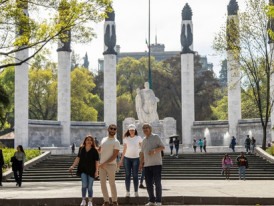
City Unscripted host and guests walking in Chapultepec Park
Chapultepec Park: Our Green Refuge
Chapultepec Park spreads across more than 1,600 acres, making it larger than New York's Central Park and infinitely more layered with history.
Families picnic under ancient ahuehuete trees while couples row boats on the lake where Aztec rulers once hunted. Bosque de Chapultepec serves as one of Mexico City's most beloved recreational spaces, where Ciudad de México residents gather for weekend relaxation.
Castillo de Chapultepec crowns the hill, offering panoramic views that stretch from the Sierra Madre mountains to the urban sprawl below.
This 18th-century palace witnessed Maximilian and Carlota's brief imperial dreams and now houses the National Museum of History. The castle's European elegance feels surreal against the backdrop of Mexico City's organized chaos.
Weekend mornings in Chapultepec reveal the park's true character.
Children feeding ducks, elderly couples dancing to mariachi music, vendors selling elotes and cotton candy, joggers circling the paths that connect monuments to playgrounds to quiet groves where you can almost forget you're in one of the world's largest cities.
Looking for a private city experience in Mexico City?
Explore the city with a local who plans a private day just for you; no groups, no scripts.

Paseo de la Reforma, Mexico City
Paseo de la Reforma: Our Champs-Élysées
Paseo de la Reforma cuts through the city like a grand boulevard from another century, connecting Chapultepec to Centro Histórico with monuments marking Mexican history's pivotal moments.
The Angel of Independence stands guard at its most famous glorieta, where locals gather to celebrate World Cup victories and mourn national tragedies alike.
Sunday mornings transform Reforma into a car-free paradise. Cyclists, runners, and families on rollerblades claim the asphalt while food vendors set up along the medians.
It's Mexico City at its most optimistic, a glimpse of what urban life could be with less traffic and more community.
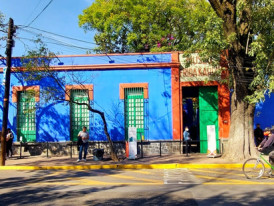
Frida Kahlo Museum (La Casa Azul) in Coyoacan
Frida Kahlo Museum: La Casa Azul
In Coyoacán, one of Mexico City's oldest neighborhoods, the Frida Kahlo Museum preserves the artist's world in cobalt blue walls and intimate rooms where pain transformed into beauty.
La Casa Azul feels more like visiting a friend's home than touring a museum. Frida's wheelchair sits beside her easel, her colorful Tehuana dresses hang in wardrobes, her kitchen still holds the clay pots she used for traditional Mexican dishes.
The garden, with its pre-Hispanic sculptures and tropical plants, creates an oasis where you can almost imagine Diego Rivera's booming laugh echoing from the studio.
The famous Mexican architect Fernando Romero drew inspiration from spaces like this when designing contemporary Mexican buildings that honor traditional aesthetics.
Book tickets in advance; this isn't just a museum visit, it's a pilgrimage for art lovers worldwide.

Architecture of Museo Soumaya with City Unscripted host and guests
Museo Soumaya and Museo Jumex: Contemporary Contrasts
These adjacent museums in Polanco represent Mexico City's contemporary artistic ambitions.
Museo Soumaya's honeycomb façade houses Carlos Slim's eclectic collection, from pre-Hispanic artifacts to European masters.
The building itself divides opinions (some call it architectural genius, others a vanity project) but the collection inside rewards patient exploration.
Museo Jumex focuses on contemporary Latin American art, its angular concrete form providing stark contrast to Soumaya's curves.
Together, they anchor Polanco's upscale shopping district while offering cultural depth beyond luxury boutiques.
What makes these attractions essential
They represent Mexico City's layered identity—indigenous roots, colonial heritage, revolutionary spirit, and contemporary ambition all coexisting in remarkable harmony.
Rosetta's Restaurant in Roma Norte
Overrated Spots and Their Better Alternatives
Skip the Tourist Traps in Polanco
Look for Mexico City's hidden gems.
Polanco's restaurant scene caters heavily to international visitors with sanitized versions of Mexican cuisine and inflated prices.
Instead of dining at hotel restaurants or international chains, head to Contramar for their legendary tuna tostadas, or discover Rosetta in Roma Norte, where Italian techniques elevate Mexican ingredients in Elena Reygadas' innovative kitchen.
For authentic upscale Mexican dining that locals actually frequent, try Quintonil or Sud 777, where chefs respect traditional flavors while pushing culinary boundaries.
Zona Rosa once claimed to be Mexico City's premier nightlife destination, but today it feels more like a tourist theme park than a genuine cultural experience.
The bars cater to foreign visitors with overpriced drinks and generic atmospheres that could exist anywhere.

Trendy bar in Roma Norte
Roma Norte and Condesa Beat Zona Rosa for Nightlife
Zona Rosa once claimed to be Mexico City's premier nightlife destination, but today it feels more like a tourist theme park than a genuine cultural experience.
The bars cater to foreign visitors with overpriced drinks and generic atmospheres that could exist anywhere.
Roma Norte and Condesa offer infinitely more authentic and varied nightlife.
In Roma Norte, Licorería Limantour crafts cocktails that celebrate Mexican spirits with international sophistication. Bósforo brings Middle Eastern flavors to the neighborhood's eclectic dining scene.
Condesa delivers everything from intimate wine bars like Maison Artemisia to dance clubs where locals actually go to dance, not pose for Instagram.
Want to discover these places with someone who actually lives here?
City Unscripted connects you with locals who tailor private Mexico City experiences around what excites you most
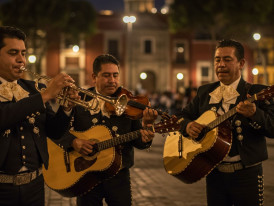
Mariachi playing in Garibaldi
Garibaldi Square: Commercialized Mariachi
Garibaldi Square markets itself as the home of mariachi, but the reality disappoints.
Aggressive performers pressure tourists into expensive serenades while authentic mariachi culture gets lost in commercial transaction.
For genuine mariachi experiences, visit Plaza Santa Cecilia on weekends, where local families hire musicians for celebrations.
Or catch mariachi performances at Pulquería Insurgente, where the music serves the community rather than tourist cameras.

Mercado San Juan in Mexico City
Skip Chain Restaurants in Centro Histórico
Centro Histórico's tourist corridors overflow with chain restaurants serving mediocre Mexican food at inflated prices. Local fondas and mercados provide infinitely better meals at a fraction of the cost.
Fonda Margarita serves home-style Mexican cooking that tastes like your grandmother made it.
Mercado San Juan offers exotic ingredients and prepared foods that adventurous eaters dream about. These authentic spots provide cultural immersion alongside delicious meals.

Los Dinamos Park. Photo by Esparta Palma, Wikicommons
Choose Los Dinamos Over Chapultepec Zoo
Chapultepec Zoo struggles with overcrowding and outdated facilities that don't reflect modern conservation standards. Los Dinamos and Parque Nacional Desierto de los Leones offer better alternatives for families seeking outdoor experiences.
Los Dinamos provides hiking trails, rivers for wading, and fresh mountain air just forty minutes from central Mexico City.
Desierto de los Leones combines forest hiking with historical ruins of a colonial monastery, plus incredible views of the Valley of Mexico.
Why these alternatives matter
They provide authentic experiences where locals actually spend time, rather than staged attractions designed primarily for tourist consumption.
Delicious tacos al pastor
Authentic Eats That Define Mexico City
The Al Pastor Taco Revolution
Al pastor tacos is Mexico City's culinary creativity at its finest. Lebanese immigrants' vertical spit-roasting technique adapted for Mexican flavors, creating something entirely new and completely ours.
The best al pastor tacos balance smoky pork with pineapple sweetness, white onion sharpness, and salsa verde heat, all wrapped in tortillas so fresh they're still steaming.
El Huequito claims to have invented al pastor in Mexico City, and their original location near Plaza Garibaldi still draws lines of locals at all hours.
Trompo Mágico elevates the technique with premium ingredients, while countless neighborhood taquerías develop their own signature variations.
Street-side trompos (vertical spits) create theater alongside flavor, skilled taqueros slice meat with balletic precision while juggling orders from hungry customers.
The sizzle of pork hitting the comal, the rhythmic chopping of onions, the ballet of assembling perfect tacos. It's performance art that ends deliciously. This is a crucial element of the best street food in Mexico City.
Want to eat the best tacos in Mexico City with a local who knows where to find them?
Book a private experience to try some of the locals' favorite tacos and learn to eat them the right way

Fruit and vegetable stand in Mercado La Merced
Street Markets and Tianguis Culture
La Merced sprawls across dozens of blocks, Mexico City's largest traditional market where vendors sell everything from exotic chiles to live chickens.
The prepared food section offers regional specialties from across Mexico - Oaxacan mole, Yucatecan cochinita pibil, Veracruz-style seafood - all prepared by families who've been perfecting these recipes for generations.
Navigating La Merced requires patience and adventurous spirit.
Vendors call out their specialties while customers haggle in Spanish, Nahuatl, and other indigenous languages.
The sensory overload - colors, aromas, sounds, textures - can overwhelm first-time visitors, but it's authentic Mexico City at its most intense.
Weekly tianguis (rotating markets) appear in different neighborhoods, bringing fresh produce, prepared foods, and community gathering to residential areas.
Tianguis San Felipe de Jesús on Tuesdays, or the massive Thursday market in Doctores, offer more manageable introductions to Mexican market culture.

Enchiladas de mole
Traditional Dishes That Tell Our Story
Chiles en nogada appear on menus during late summer, celebrating Mexican independence with colors of our flag. Green poblano chiles, white walnut cream sauce, red pomegranate seeds.
This complex dish requires days of preparation, making it a special occasion food that Mexican families associate with patriotic celebrations.
Tamales vary by region and season, but Mexico City's versions tend toward larger size and complex fillings. Tamales rojos with chicken in red sauce, tamales verdes with pork in salsa verde, sweet tamales with raisins and pineapple. Each represents hours of labor that transforms masa into edible art.
Mole reaches its peak complexity in Mexico City's best restaurants, where chefs balance dozens of ingredients into sauces that taste simultaneously familiar and mysterious.
Mole poblano's chocolate notes complement turkey or chicken, while mole coloradito's earthier profile pairs with pork or beef.

Octopus, Habanero Ink, Ayocote, Veracruzana Sauce, Pujol. Photo by Premshree Pillai, Flickr
High-End Mexican Restaurants Locals Love
Pujol under Enrique Olvera has revolutionized Mexican fine dining while respecting traditional ingredients and techniques.
The famous mole madre, mole nuevo dish presents two moles, one aged 1,000+ days, another made fresh, that diners mix to explore how time transforms flavor.
Quintonil showcases Mexican biodiversity through Jorge Vallejo's innovative interpretations of traditional ingredients.
Dishes like escamoles (ant larvae) with epazote, or quelites (wild greens) with aged cheese, introduce diners to flavors that most Mexicans have forgotten.
Sud 777 occupies a converted house in Pedregal, where Edgar Núñez creates sophisticated Mexican cuisine that changes seasonally.
The restaurant's garden supplies herbs and vegetables that appear on plates within hours of harvest.
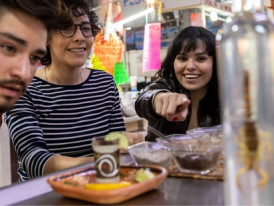
City Unscripted host and guests trying Mezcal from a bottle with a scorpion in Mercado de San Juan
Mercado de San Juan: Culinary Adventure Central
Mercado de San Juan caters to adventurous eaters seeking ingredients unavailable elsewhere in Mexico City.
Vendors sell crocodile meat, exotic mushrooms, imported cheeses, unusual chiles, and prepared foods that challenge preconceptions about Mexican cuisine.
The market attracts professional chefs sourcing rare ingredients alongside curious food lovers seeking new experiences.
Escamoles (ant larvae), chapulines (grasshoppers), and gusanos de maguey (agave worms) provide protein-rich alternatives to conventional meat, while exotic fruits like rambutan and dragon fruit add tropical variety to traditional Mexican palates.
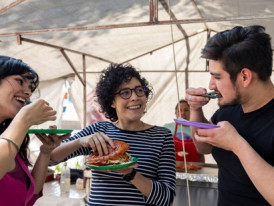
Traditional pambazos, quesadillas and tlacoyos.
Essential Street Food Experiences
Esquites and elotes vendors appear on every corner, serving corn kernels or whole cobs with mayonnaise, cotija cheese, chile piquín, and lime. Simple ingredients that create addictive flavor combinations.
Each vendor develops signature variations, some adding Valentina hot sauce, others preferring chile en polvo, creating neighborhood loyalty among regular customers.
Gorditas stuffed with chicharrón prensado, quesadillas filled with flor de calabaza or huitlacoche, pambazos soaked in red salsa and filled with chorizo and potato.
These handheld meals provide quick, satisfying sustenance that construction workers, office employees, and school children all enjoy.

Blue tlacoyo with cream, cheese and salsa.
Tlacoyos represent indigenous Mexican cuisine at its most authentic. Oval masa cakes stuffed with beans, cheese, or chicharrón, then topped with salsa, cheese, and nopales.
Vendors cooking tlacoyos on comals demonstrate techniques unchanged since pre-Hispanic times.
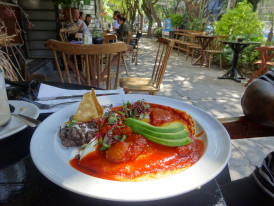
Huevos Rancheros in Colonia Condesa
Local Breakfast Traditions
Chilaquiles appear on breakfast tables across Mexico City, transforming yesterday's tortillas into today's satisfying meal.
Tortilla chips bathed in red or green salsa, topped with fried eggs, Mexican crema, and cotija cheese create comfort food that varies by family recipe and regional preference.
Huevos rancheros provide protein-rich breakfast fuel: fried eggs over tortillas with salsa ranchera, often accompanied by refried beans and fresh avocado slices.
Simple preparation masks complex flavor development in the salsa, where tomatoes, onions, and chiles char on comals before blending.
Tamales con atole create the perfect breakfast pairing: warm, masa-based tamales complemented by warm, masa-based atole (thin porridge). Mexico City Street food vendors selling both from steam pots provide portable breakfast for commuters heading to work or school.
Pan dulce from neighborhood panaderías offers endless variety: conchas, orejas, cuernos, empanadas, each with distinct shapes, flavors, and textures that Mexican families enjoy with café de olla or hot chocolate.

Tacos de barbacoa
Weekend Culinary Traditions
Sunday barbacoa is Mexico City's most social eating experience.
Families gather at neighborhood barbacoa specialists where whole lamb shoulders cook overnight in underground ovens, creating impossibly tender meat served with handmade tortillas, consommé, and multiple salsas.
Birria spots across the city serve Jalisco's signature dish: beef or goat stewed in complex chile sauce until fork-tender.
The rich, red broth provides the base for consommé that diners sip between bites of meat-stuffed tacos.
Carnitas vendors set up massive copper pots filled with pork simmering in its own fat, creating meat so tender it falls apart at touch.
Michoacán-style carnitas maintain traditional preparation methods while Mexico City adaptations incorporate local preferences and ingredients.
What makes Mexico City's food scene special
It preserves ancient techniques while embracing innovation, creating a culinary landscape where street vendors and Michelin-starred chefs draw from the same rich tradition of Mexican flavors.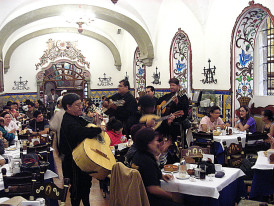
Café de Tacuba. Photo by Hmaglione10, Wikicommons
Mexico City's Café and Dessert Culture
Traditional Cafés in Centro Histórico
Café de Tacuba has served chilangos since 1912, its Art Nouveau interior preserving early 20th-century elegance while traditional Mexican coffee service continues unchanged.
The café con leche arrives in heavy ceramic cups alongside pan dulce from their own bakery, creating breakfast rituals that generations of Mexico City families share.
Gran Café de la Parroquia brings Veracruz coffee culture to the capital, where waiters in bow ties perform the theatrical lechero service - hot milk poured from impressive heights into glasses containing strong espresso, creating layered drinks that taste as dramatic as they look.
These traditional cafés preserve Mexico City's leisurely café culture, where business deals develop over multiple cups, friends catch up during extended sobremesas, and solitary readers claim corner tables for hours of undisturbed literary consumption.
What if your day in Mexico City was planned by someone who knows it - and you?
City Unscripted matches you with a local host who creates a private experience based on your interests, not a set route.

Cafe Ojo de Agua in Colonia Condesa
Trendy Coffee Shops in Roma Norte and Condesa
Roma Norte and Condesa have embraced third-wave coffee culture while maintaining distinctly Mexican character.
Cardinal Casa de Café sources beans directly from Mexican producers, creating single-origin options that showcase our country's coffee biodiversity alongside expertly crafted espresso drinks.
Starbucks might dominate shopping centers, but local coffee shops provide more interesting experiences.
Buna Café in Roma Norte occupies a converted house where baristas discuss terroir and processing methods with the passion of wine sommeliers.
Café Avellaneda in Condesa combines specialty coffee with books, creating intellectual gathering spaces where customers debate literature over cortados.
These modern coffee shops attract digital nomads, creative professionals, and young Mexicans who view specialty coffee as lifestyle choice rather than mere caffeine delivery.
The atmosphere balances productivity with sociability. Laptop users coexist with conversation groups while baristas craft drinks that qualify as liquid art.

Churros from El Moro
Iconic Dessert Destinations
El Moro has served churros to Mexico City since 1935, their original location near Alameda Central maintaining recipes and preparation methods that create churros crispy outside, tender inside.
The chocolate for dipping arrives thick enough to coat churros completely, sweet enough to satisfy children, complex enough to please adults.
Lines at El Moro stretch around corners during weekend evenings, but the wait rewards patience.
Fresh churros dusted with sugar or filled with dulce de leche provide handheld dessert perfection that pairs ideally with Mexican hot chocolate or café de olla.
Nevería Roxy represents old-school ice cream perfection, their handmade helados using seasonal fruits and traditional Mexican flavors.
Mamey, zapote negro, tuna (prickly pear), and other indigenous fruits create ice cream flavors unavailable anywhere else in the world.

Fresh fruit ice cream
Traditional Heladerías and Neverías
La Especial de París maintains French-influenced ice cream traditions adapted for Mexican tastes, their sorbet-style nieve using fresh fruit purées that preserve natural flavors and vibrant colors.
Mango con chile, limón con chile, tamarindo, these flavor combinations sound unusual to foreign visitors but represent perfectly balanced sweet-tart-spicy profiles that Mexican palates crave.
Helados Palmeiro specializes in artisanal gelato using premium ingredients imported from Europe combined with Mexican fruits and spices.
Their café de olla gelato captures the essence of cinnamon-spiced Mexican coffee in frozen form, while horchata gelato transforms the traditional rice-based drink into creamy dessert luxury.
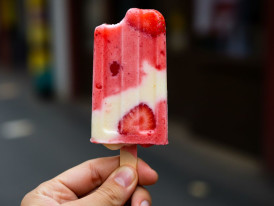
Fresh strawberries and cream
Helados Cometa focuses on seasonal availability, their flavors changing based on what fruits Mexican producers harvest.
Spring brings strawberry and guava options, summer emphasizes mango and watermelon varieties, autumn introduces apple and pear choices, winter highlights citrus and exotic fruit combinations.
These traditional heladerías preserve dessert-making techniques that emphasize natural ingredients over artificial additives, creating ice creams and sorbets that taste like concentrated fruit rather than sugary substitutes.
What defines Mexico City's café and dessert culture
It balances international sophistication with distinctly Mexican flavors, creating gathering places where traditional social customs adapt to contemporary urban life.
La Ciudadela Crafts Market
Shopping Experiences That Capture Mexico City's Character
Artisanal Crafts at Ciudadela Market
Ciudadela Market showcases Mexican artisanal traditions from across the republic, bringing Oaxacan textiles, Michoacán pottery, Pueblan talavera, and countless other regional specialties to central Mexico City.
Unlike tourist-focused markets that prioritize volume over quality, Ciudadela attracts serious collectors and local families seeking authentic crafts for special occasions.
Vendors here maintain relationships with artisan communities in their home states, ensuring that purchases support traditional craftspeople rather than factory-produced imitations.
Hand-woven rebozos from Santa María del Río cost significantly more than machine-made versions, but the quality difference appears immediately in texture, durability, and intricate design work.
The market's organization by craft type - textiles in one section, pottery in another, jewelry elsewhere - allows focused shopping while encouraging exploration.
Prices require negotiation, but vendors respect customers who demonstrate knowledge about traditional techniques and regional variations.

La Lagunilla Vintage Market. Photo by AlejandroLinaresGarcia via Wikicommons
Vintage Treasures in La Lagunilla
La Lagunilla operates Sunday mornings as Mexico City's premier vintage and antique market.
Vendors sell everything from Art Deco furniture to vintage lucha libre masks. The market attracts collectors searching for specific items alongside casual browsers seeking unique decorative pieces.
Mexican mid-century modern furniture appears regularly. Pieces by Clara Porset, designs influenced by Luis Barragán's architectural vision, and handcrafted items that represent Mexico's golden age of design innovation.
Vintage Mexican cinema posters, especially from the Golden Age of Mexican film, command premium prices from collectors worldwide.

Palacio de Hierro Shopping Center in Polanco. Photo by Gzzz via Wikicommons
High-End Shopping in Polanco
Polanco concentrates Mexico City's luxury retail scene, from international fashion houses to exclusive Mexican designers who showcase our country's contemporary creative talent.
Antara Fashion Hall and Palacio de Hierro provide climate-controlled environments where affluent chilangos browse the same brands available in New York, Paris, or Milan.
Mexican luxury brands like Carla Fernández reinterpret indigenous textile traditions through contemporary fashion design, creating clothing that celebrates Mexican heritage while meeting international style standards.
Yakampot transforms traditional Mexican leatherworking into modern handbags and accessories that compete with European luxury goods.
The shopping experience in Polanco emphasizes service and exclusivity. Personal shoppers, private fitting rooms, complimentary alterations, and other amenities that justify premium pricing.
International visitors can arrange tax-free shopping while locals enjoy seasonal sales that make luxury goods more accessible.

Small independent boutique in Colonia Roma
Boutique Shopping in Roma and Condesa
Roma Norte and Condesa offer more eclectic shopping experiences.
Independent boutiques mix vintage finds with contemporary Mexican designs and international imports selected by discerning owners with distinctive aesthetic visions.
Under the Volcano Books provides English-language literature alongside Mexican authors in translation, creating intellectual gathering spaces where literary discussions develop naturally.
Goodbye Folk combines vintage Mexican graphic design with contemporary reinterpretations, offering posters, books, and artifacts celebrating Mexico City's visual culture.
Local fashion designers operate small boutiques showcasing limited production runs that emphasize quality over quantity.
Common People features Mexican streetwear brands that incorporate indigenous design elements into urban fashion, while Lorena Saravia creates elegant women's clothing using traditional Mexican textiles in contemporary silhouettes.
These neighborhoods reward pedestrian exploration - small galleries, design studios, specialty shops, and creative spaces occupy converted houses and ground-floor apartments, creating shopping districts that feel more like cultural districts than commercial zones.

Bazar del Sábado in San Angel. Photo by Inakiherrasti via Wikicommons
Bazar del Sábado in San Ángel
Bazar del Sábado transforms San Ángel's colonial plaza into a Saturday art market where established and emerging Mexican artists sell original paintings, sculptures, jewelry, and crafts directly to collectors and casual buyers.
The juried market maintains quality standards while encouraging artistic experimentation.
Oil paintings of Mexican landscapes, abstract interpretations of indigenous themes, and contemporary photography documenting urban Mexico City life.
The artistic variety reflects Mexico's visual culture diversity. Prices range from affordable student work to investment-quality pieces by recognized Mexican artists.
The colonial architecture surrounding the plaza creates appropriate atmosphere for art appreciation. 18th-century buildings frame contemporary creativity while traditional Mexican food vendors provide sustenance for extended browsing sessions.
Live music and cultural performances complement the visual arts display, creating festival atmosphere that attracts local families alongside serious art collectors. Children participate in art workshops while parents examine potential purchases, making the bazar family-friendly cultural experience.
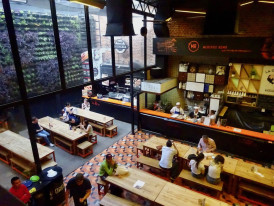
Mercado Roma in Colonia Roma
Mercado Roma: Trendy Food and Shopping Hub
Mercado Roma is Mexico City's contemporary market evolution, combining traditional Mexican food culture with modern retail design and international influences.
Gourmet food vendors serve elevated versions of Mexican classics alongside international cuisines adapted for local tastes.
The market attracts young professionals, food enthusiasts, and international visitors seeking Mexican culinary experiences in comfortable, modern environments.
Craft beer from Mexican breweries, artisanal mezcal tastings, specialty coffee preparations, the beverage options reflect Mexico's growing appreciation for premium alcoholic and non-alcoholic drinks..
What makes Mexico City shopping special
It preserves traditional craftsmanship while embracing contemporary retail innovation, creating commercial experiences that support Mexican artisans and designers while satisfying international quality expectations.More than 26,223 5-star reviews and counting
26,223+ 5-Star Reviews and Counting
Trusted and recommended by travelers worldwide.

Iconic fountain in Coyoacan
Neighborhood Explorations: Mexico City's Diverse Districts
Coyoacán: Where Art Meets History
Coyoacán preserves colonial charm while celebrating Mexico's artistic legacy, its cobblestone streets and tree-lined plazas creating atmosphere that transported visitors to earlier centuries.
Weekend markets fill Plaza Hidalgo with artisans selling handmade crafts while musicians perform traditional Mexican songs that echo off colonial architecture.
The neighborhood's artistic heritage extends beyond Frida Kahlo.
Leon Trotsky's final home sits blocks away, now a museum documenting the Russian revolutionary's Mexican exile. Diego Rivera and Frida's shared studio space reveals their creative partnership while demonstrating how international artistic movements influenced Mexican cultural development.
Jardín Centenario provides green refuge where families picnic beneath enormous trees while children play on traditional playground equipment.
Street performers, from mime artists to mariachi musicians, create entertainment that changes throughout the day as different audience preferences emerge.
Local cantinas preserve traditional Mexican drinking culture where mezcal and pulque flow alongside philosophical discussions that continue until dawn.
La Guadalupana and La Coyoacana maintain authentic atmospheres where local residents gather for domino games and political debates that define Mexican social interaction.
Traditional markets operate throughout the week, selling fresh produce, prepared foods, and household items to neighborhood residents.
These markets provide insights into daily Mexican life away from tourist attractions, where Spanish conversations mix with indigenous languages and traditional commerce methods persist alongside modern payment systems.

Cibeles Fountain in Colonia Roma
Roma Norte: Hip Culture and Creative Energy
Roma Norte represents Mexico City's contemporary cultural renaissance, where art galleries, independent bookstores, specialty coffee shops, and innovative restaurants occupy beautifully restored early 20th-century architecture.
The neighborhood attracts creative professionals, international residents, and young Mexicans who appreciate cultural sophistication alongside urban convenience.
Álvaro Obregón avenue creates the neighborhood's main commercial spine, lined with restaurants serving everything from traditional Mexican cuisine to international fusion experiments.
Contramar draws seafood lovers with their legendary tuna tostadas, while Rosetta elevates Italian techniques using Mexican ingredients in Elena Reygadas' innovative kitchen.
Street art covers walls throughout the neighborhood, from large-scale murals celebrating Mexican culture to smaller interventions that comment on contemporary urban life.
Roma Norte balances artistic expression with residential functionality, creating neighborhood atmosphere that encourages both creative productivity and comfortable daily living.
Local bars craft cocktails that celebrate Mexican spirits - mezcal, tequila, sotol, raicilla - while incorporating international mixology techniques.
Licorería Limantour creates drinks that taste distinctly Mexican while meeting international cocktail standards, attracting both local residents and international visitors seeking things to do in Mexico City at night.
The neighborhood's walkability encourages pedestrian exploration, where small galleries, design studios, specialty shops, and cultural spaces occupy converted houses and ground-floor commercial spaces.
This human-scale development creates urban environment that prioritizes community interaction over automobile convenience.

Parque España in Colonia Condesa
Condesa: Parks, Eateries, and Nightlife
Condesa combines urban density with abundant green space, its tree-lined streets and central parks creating a residential atmosphere that attracts families alongside young professionals seeking balanced city living.
Parque México and Parque España provide recreational opportunities that support community gathering while offering refuge from urban intensity.
The neighborhood's restaurant scene spans from casual taquerías to upscale dining establishments, creating options serving local residents while attracting visitors across Mexico City.
Merotoro serves contemporary Mexican cuisine in an intimate setting, while Pujol pushes Mexican culinary boundaries through Enrique Olvera's innovative interpretations of traditional ingredients.
Art Deco architecture defines much of Condesa's visual character, with restored buildings showcasing 1930s and 1940s design elements that create a distinctive neighborhood identity.
These buildings house contemporary businesses while preserving historical architectural details that connect present residents to earlier generations of chilangos.
Nightlife options range from intimate wine bars to energetic dance clubs, creating entertainment variety for different age groups and cultural preferences.
Bósforo brings Middle Eastern cuisine and atmosphere to the Mexican neighborhood, while traditional cantinas maintain Mexican drinking culture alongside modern cocktail establishments.
The neighborhood's circular street pattern, based on the original hippodrome design, creates a unique urban layout that encourages walking while providing multiple route options between destinations.
This infrastructure supports pedestrian-friendly commercial development, making Condesa one of Mexico City's most livable districts.
Want to explore these cool neighborhoods with a local?
Uncover the quirks, charm, and coolest spots of Roma and Condesa on a private experience designed just for you.

Image by DEZALB from Pixabay
Xochimilco: Traditional Canals and Floating Gardens
Xochimilco preserves Aztec agricultural techniques through its floating garden system, where chinampas (artificial islands) continue producing flowers and vegetables using methods unchanged since pre-Hispanic times.
The UNESCO World Heritage site demonstrates sustainable agriculture that supported Tenochtitlan's massive population.
Trajineras (colorful boats) carry visitors through canals while mariachi musicians and food vendors create floating entertainment that celebrates Mexican culture.
Weekend trips become extended parties where families gather for hours-long celebrations, including traditional Mexican music, authentic food, and abundant alcoholic beverages.
The experience provides insight into Mexico City's pre-urban landscape, when lake systems covered the Valley of Mexico and indigenous communities developed sophisticated water management techniques.
Modern Mexico City's water problems contrast sharply with Xochimilco's abundance, creating educational opportunities alongside recreational experiences.
Local communities maintain traditional crafts, from boat building to flower cultivation, providing economic alternatives to urban migration while preserving cultural knowledge that connects contemporary Mexico to its indigenous heritage.
Visiting Xochimilco supports these traditional livelihoods while offering authentic cultural experiences unavailable elsewhere in Mexico City.
Environmental challenges threaten Xochimilco's future - urban development pressure, water contamination, and habitat loss create conservation urgency.
Tourism revenue helps fund preservation efforts while raising awareness about Mexico City's environmental challenges and indigenous heritage conservation needs.

Museo Casa Estudio Diego Rivera y Frida Kahlo in San Angel
San Ángel: Historic Charm and Art Markets
San Ángel maintains colonial architecture and traditional plaza layout that transports visitors to Mexico's viceregal period, its stone buildings and narrow streets creating an atmosphere that predates Mexico City's urban expansion.
The neighborhood preserves small-town character within the metropolis, offering refuge from urban intensity.
Saturday art markets transform the central plaza into an outdoor gallery where Mexican artists sell original paintings, sculptures, and crafts directly to collectors and casual buyers.
The juried market maintains quality standards while encouraging artistic experimentation, creating a commercial environment that supports Mexican creative professionals.
Museo Casa Estudio Diego Rivera y Frida Kahlo occupies the modernist houses where Mexico's most famous artistic couple lived and worked during their final years.
The preserved studios reveal their creative processes while demonstrating how Mexican artists engaged international modernist movements during the mid-20th century.
Traditional restaurants serve classic Mexican cuisine in colonial settings where families gather for extended weekend meals.
San Ángel Inn occupies a restored 17th-century hacienda where traditional Mexican hospitality meets contemporary dining expectations, creating experiences celebrating Mexican culinary heritage.
The neighborhood's religious heritage appears in Iglesia del Carmen, whose baroque interior houses colonial art and religious artifacts demonstrating Mexican Catholic culture's visual richness.
Religious festivals throughout the year bring community celebrations that maintain traditional Mexican spiritual customs.

Lucerna Comedor Food Hall in Juarez
Juárez: Diverse Dining and Emerging Culture
Juárez is Mexico City's cultural frontier, where emerging restaurants, stylish bars, and creative spaces occupy converted buildings in a neighborhood undergoing rapid transformation.
The area attracts adventurous diners and cultural explorers seeking experiences beyond established tourist destinations.
New restaurants experiment with Mexican cuisine while respecting traditional flavors and techniques. Em serves contemporary Mexican food in a minimalist setting that emphasizes ingredient quality over elaborate presentation, while Maison Artemisia combines natural wine selection with French-influenced Mexican cuisine in an intimate bistro atmosphere.
The neighborhood's proximity to Zona Rosa and Centro Histórico provides convenient access to major attractions while offering more affordable dining and entertainment options than Mexico City's established cultural districts.
This accessibility attracts both local residents and international visitors seeking authentic experiences at reasonable prices.
Street art and gallery spaces contribute to Juárez's emerging cultural identity, where Mexican and international artists create works that comment on urban transformation, gentrification, and cultural preservation.
These artistic interventions provide visual interest while documenting neighborhood change in real time.
Mixed-use development combines residential, commercial, and cultural functions to create a pedestrian-friendly environment that supports community interaction.
This urban planning approach demonstrates Mexico City's potential for sustainable development, balancing economic growth with neighborhood character preservation.
What makes Mexico City's neighborhoods special
Each district maintains a distinct identity while contributing to the city's overall cultural richness, creating urban diversity that supports different lifestyle preferences while preserving historical and cultural authenticity.Want to make the most of your trip to Mexico City?
Book a private experience tailored to your curiosity, so you discover more than you would on your own.

Street art in Colonia Roma
Things to Do by Interest: Tailored Mexico City Experiences
Art and Culture Enthusiasts
Street art exploration in Roma Norte and Condesa reveals Mexico City's contemporary artistic expression, where international muralism traditions merge with modern urban art movements.
Yesca and other local artists create large-scale works that comment on Mexican social issues while demonstrating technical mastery that rivals museum-quality painting.
Self-guided walking tours through these neighborhoods reveal artistic evolution as you move from block to block. Social realist murals celebrating indigenous heritage transition to abstract interpretations of urban life, while smaller interventions comment on gentrification, political change, and cultural preservation.
Contemporary galleries throughout Roma Norte showcase emerging Mexican artists alongside established names, creating exhibition spaces that bridge the commercial art market with cultural exploration.
Proyectos Monclova and OMR represent Mexico City's growing international art scene reputation while supporting local artistic development.
Local artist studios open periodically for public visits, providing opportunities to meet Mexican artists and observe creative processes firsthand.
These studio visits offer insights into how contemporary Mexican artists engage international art movements while maintaining connections to national cultural traditions.
Art walks organized by local cultural groups combine neighborhood exploration with artistic education, providing context for understanding how Mexico City's artistic scene reflects broader social and economic changes affecting the capital.

Antiguo Convento del Desierto de los Leones. Photo by Rage Against via Wikicommons
Outdoor Activity Seekers
Bike rides along Paseo de la Reforma take advantage of Sunday morning road closures, when thousands of cyclists, runners, and pedestrians claim the major boulevard for car-free recreation.
Bike rental stations throughout the city provide convenient access to Mexico City's expanding cycling infrastructure.
The route extends from Chapultepec to Centro Histórico, passing major monuments while demonstrating Mexico City's potential for sustainable transportation.
Food vendors along the route provide traditional Mexican snacks and fresh fruit juices that fuel extended cycling sessions.
Hiking near Ajusco Volcano offers mountain experiences within reach of urban Mexico City. Pine forests and volcanic landscapes provide a dramatic contrast to the city environment.
Multiple trail options accommodate different fitness levels while offering spectacular views of the Valley of Mexico.
The area provides habitat for wildlife rarely seen in urban areas.
Hawks, deer, and numerous bird species that demonstrate Mexico City's biological diversity beyond the built environment. Weekend hiking provides physical exercise alongside environmental education about Mexico's natural heritage.
Desierto de los Leones National Park combines forest hiking with historical exploration.
Colonial monastery ruins occupy mountain locations that early Spanish monks chose for religious contemplation.
The park provides camping opportunities for overnight nature experiences within Mexico City's municipal boundaries.
Trail systems connect different park areas and provide varying difficulty levels, accommodating family groups alongside serious hikers.
The cooler mountain climate offers relief from Mexico City's urban heat while providing recreational opportunities that don't require extended travel.
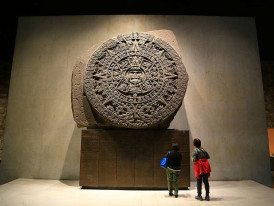
Aztec Calendar at the Museo Nacional de Antropología
Historical Interest Travelers
Self-guided historical walking tours through Centro Histórico reveal architectural layers that document Mexico City's evolution from Aztec capital through colonial viceroyalty to modern metropolis.
Each building tells stories about political change, cultural adaptation, and architectural innovation that shaped contemporary Mexico.
Pre-Hispanic foundations appear beneath colonial structures, while 19th and 20th-century additions demonstrate Mexico's engagement with international architectural movements.
These architectural palimpsests provide visual evidence of cultural continuity alongside dramatic historical change.
Archaeological exploration extends beyond famous sites to lesser-known locations that provide insights into pre-Hispanic Mexico City.
Tlatelolco preserves Aztec market foundations alongside colonial church construction, creating archaeological site that documents conquest and cultural synthesis.
Cuicuilco pyramid predates Teotihuacan construction, demonstrating ancient urban development in the Valley of Mexico that contradicts simplified narratives about pre-Hispanic civilization.
These sites require more effort to reach but reward visitors with archaeological experiences without tourist crowds.
Museum visits complement archaeological exploration by providing artifact contexts and historical interpretation that connect physical remains to broader cultural developments.
Museo del Templo Mayor and Museo Nacional de Antropología provide comprehensive introductions to pre-Hispanic Mexican civilizations.
Historical markets like La Merced continue commercial traditions that connect contemporary Mexico City to its pre-Hispanic and colonial economic foundations.
These markets provide living history experiences where traditional commerce methods persist alongside modern retail innovations.
Day Trips from Mexico City
While Mexico City has an endless number of attractions, some of the most memorable experiences lie just outside the city limits. Taking day trips from Mexico City is a great way to explore ancient ruins, colonial towns, and natural wonders without the hassle of a full-scale move. Popular destinations include the pyramids of Teotihuacan, the historic city of Puebla, or the picturesque town of Cholula, each offering a unique glimpse into the country's rich heritage and landscape.
Want to experience the real Mexico City with someone who lives there?
A fully private experience, planned and led by a local host who tailors the day to you

Diego Rivera Mural at the Palacio Nacional. Photo by Drkgk via Wikicommons
Cultural and Historical Insights: Understanding Mexico City's Soul
Diego Rivera Murals at Palacio Nacional
Diego Rivera's murals at Palacio Nacional represent Mexico's most ambitious artistic historical narrative.
They cover walls and staircases with visual storytelling that spans pre-Hispanic civilizations through the Mexican Revolution. Rivera spent years researching historical details while developing artistic techniques that made complex historical narratives accessible to viewers regardless of literacy levels.
The main staircase mural, "The History of Mexico," presents a chronological narrative from the Aztec empire through the post-revolutionary period.
It uses allegorical figures and historical portraits to celebrate indigenous heritage while critiquing colonial and contemporary political systems.
Rivera's visual storytelling emphasizes Mexican civilization's sophistication while documenting exploitation and resistance.
The detailed work rewards careful examination. Individual faces represent historical figures, symbolic elements comment on political relationships, and architectural elements reference specific locations throughout Mexico.
Rivera embedded multiple narrative layers that provide different meanings based on viewers' historical knowledge and political perspectives.
The murals function as public education tools, making Mexican history accessible to populations excluded from formal educational opportunities.
Rivera's communist political beliefs influenced his historical interpretations, emphasizing class struggle and indigenous rights while critiquing capitalist economic systems.
Contemporary viewers can appreciate artistic technique while considering how Rivera's political perspectives shaped historical narrative.
The murals represent a moment in Mexican cultural development when revolutionary ideals influenced artistic production and public art explicitly served political functions.

City Unscripted host and guest viewiing the Piramide del Sol in Teotihuacan
Independent Teotihuacan Exploration
Teotihuacan deserves full-day exploration that goes beyond standard tourist itineraries to understand how this ancient metropolis influenced Mexican civilization development.
The site's urban planning, architectural innovation, and artistic achievement demonstrate sophisticated civilization that predated European urban development by centuries.
Pyramid of the Sun and Pyramid of the Moon anchor monumental architecture that organized ceremonial and residential areas according to astronomical alignments and religious beliefs that connected human activity to cosmic cycles.
Climbing these structures provides physical appreciation for engineering achievement alongside spectacular valley views.
The Temple of Quetzalcoatl displays intricate stone carvings that demonstrate artistic sophistication while providing insights into Teotihuacan religious beliefs and political organization.
Recent archaeological discoveries continue to reveal new information about this civilization's complexity and international connections.
Independent exploration allows personal pacing that accommodates different interests.
Some visitors focus on architectural details, others emphasize archaeological evidence, and many simply appreciate the monumental scale that demonstrates human creative capacity. Audio guides provide historical context while allowing individualized touring schedules.
The site museum displays artifacts that provide context for understanding Teotihuacan's daily life, artistic production, and economic systems.
Obsidian tools, ceramic vessels, and jewelry demonstrate technological sophistication while revealing trade connections throughout Mesoamerica.
Early morning visits avoid crowds while providing optimal lighting for photography and comfortable temperatures for extended walking.
The site's scale requires significant walking, making physical preparation important for enjoyable visits.
Explore Teotihuacan on a private day trip with a local host
Skip the stress of planning and discover Teotihuacan with a local who’ll bring its incredible history to life.

Museo de Arte Moderno Entrance. Photo by Gobierno CDMX via Wikicommons
Museo de Arte Moderno: Mexican Contemporary Art
Museo de Arte Moderno shows off Mexican artistic development throughout the 20th century, demonstrating how Mexican artists engaged international modernist movements while maintaining connections to national cultural traditions.
The collection provides a comprehensive introduction to Mexican contemporary art beyond famous names like Rivera and Kahlo.
Rufino Tamayo, José Clemente Orozco, David Alfaro Siqueiros, and other Mexican modernists developed distinctive styles that incorporated pre-Hispanic aesthetic elements,
European avant-garde techniques, and revolutionary political themes.
Their work demonstrates Mexican artistic independence from European and North American cultural domination.
Contemporary exhibitions feature emerging Mexican artists who continue developing distinctly Mexican expressions while participating in international art movements.
These shows provide insights into Mexican cultural concerns while demonstrating artistic continuity with earlier generations of Mexican creators.
The museum's architecture complements artistic collections while providing appropriate display environments for different media.
Painting, sculpture, photography, and installation art that represent Mexico's contemporary cultural production.
Garden spaces display outdoor sculptures while providing recreational areas that encourage extended visits.
Educational programs include lectures, workshops, and guided tours that provide context for understanding Mexican art's historical development.
These programs attract local students and international visitors seeking deeper cultural understanding beyond casual museum visits.
The museum's location in Chapultepec provides opportunities to combine cultural visits with outdoor recreation, creating full-day experiences that balance intellectual engagement with physical activity in Mexico City's premier urban park.
What makes these cultural insights valuable?
They provide frameworks for understanding Mexico City's artistic and historical significance while encouraging personal exploration beyond surface-level tourist experiences.Frequently Asked Questions About Mexico City
Is Mexico City Safe for Tourists?
Three days introduce Mexico City's major attractions while leaving you hungry for return visits. Focus on 2 to 3 neighborhoods rather than trying to cover everything. Centro Histórico plus Roma Norte/Condesa, or Coyoacán plus Chapultepec, create manageable itineraries that allow deeper exploration over superficial sightseeing.
Day one should emphasize the Centro Histórico for historical context, including Zócalo, Palacio Nacional, and Templo Mayor. Day two can explore Chapultepec Park and museums, while day three allows neighborhood wandering in Roma Norte or Coyoacán, depending on your interests. Art and nightlife versus historical charm and markets.
Extended stays reveal Mexico City's true character through repeated visits to favorite restaurants, deeper exploration of specific neighborhoods, and participation in local cultural events that require planning. The city rewards familiarity with layers of complexity that only a few brief visits can glimpse.
Three day visitors should prioritize experiences over attractions, sharing meals at local restaurants, walking neighborhood streets, and engaging local culture provide more meaningful memories than rushing through museum checklist obligations.
What Area Has the Best Nightlife in Mexico City?
Roma Norte and Condesa offer Mexico City's most sophisticated nightlife scene. Craft cocktails, innovative restaurants, and diverse entertainment options create experiences that locals actually enjoy rather than tourist focused venues designed for one time visits.
Roma Norte's nightlife emphasizes quality over quantity. Licorería Limantour crafts world class cocktails using Mexican spirits, while Bósforo provides intimate dinner experiences that extend into late night socializing. The neighborhood attracts creative professionals and international residents who appreciate cultural sophistication.
Condesa offers more variety, from wine bars to dance clubs, creating options for different age groups and entertainment preferences. Parker & Lenox serves natural wines in an intimate setting, while Departamento provides dance floor experiences that attract young Mexicans rather than international party tourists.
Polanco nightlife caters to affluent clientele with upscale establishments that emphasize luxury over authenticity. These venues provide polished experiences but often lack the cultural authenticity that makes Roma Norte and Condesa nightlife distinctly Mexican.
Centro Histórico maintains traditional cantina culture alongside modern bars, creating nightlife options ranging from historic pulquerías to contemporary cocktail establishments. This area provides cultural education alongside entertainment.
Is Mexico City Walkable?
Mexico City's walkability varies dramatically by neighborhood and destination combinations. Roma Norte, Condesa, Coyoacán, and San Ángel provide pedestrian friendly environments where most attractions, restaurants, and shops lie within reasonable walking distances.
Centro Histórico offers concentrated attractions that support walking tours, but air quality and crowd density can make extended pedestrian exploration challenging. The area works best for focused visits rather than casual neighborhood strolling.
Chapultepec Park provides extensive walking opportunities in a green environment, but reaching the park from other neighborhoods typically requires transportation. Once you arrive, the park's internal pathways reward pedestrian exploration.
The distance between neighborhoods makes walking impractical for comprehensive city exploration. Roma Norte to Centro Histórico requires 45 minutes of walking through less interesting transitional areas, making transportation preferable for inter neighborhood movement.
Infrastructure challenges include uneven sidewalks, heavy traffic, and air pollution that can make walking less pleasant than in cities designed for pedestrian priority. However, individual neighborhoods reward walking once you arrive via transportation.
Safety considerations support walking during daylight hours in tourist and residential areas, while evening pedestrian activity should focus on well lit areas with regular foot traffic and commercial activity.
What Is Mexico City Most Known For?
Mexico City's global reputation rests on its extraordinary cultural heritage, which spans from Aztec civilization through contemporary artistic innovation. The city serves as Mexico's political, economic, and cultural capital while maintaining its authentic Mexican character despite international influences.
Culinary excellence attracts food enthusiasts worldwide, from street tacos to Michelin starred restaurants that celebrate Mexican ingredients and techniques. The city's food scene preserves traditional flavors while embracing culinary innovation that influences international Mexican cuisine development.
Artistic legacy includes Diego Rivera murals, Frida Kahlo's iconic imagery, and contemporary Mexican artists who continue developing distinctly Mexican artistic expressions. Major museums house world class collections while neighborhood galleries showcase emerging talent.
Historical significance encompasses Aztec archaeological sites, colonial architecture, and revolutionary history that shaped modern Mexico. The city preserves these historical layers while functioning as a dynamic contemporary metropolis.
Cultural authenticity distinguishes Mexico City from other international capitals. Despite modernization, the city maintains Mexican customs, languages, and social traditions that provide visitors with genuine cultural experiences rather than sanitized tourist presentations.
What's the Best Month to Visit Mexico City?
October through April provides optimal weather conditions with comfortable temperatures, minimal rainfall, and excellent air quality, making outdoor exploration pleasant. This dry season coincides with peak tourist season, requiring reservations for popular restaurants and attractions.
March and April offer perfect weather conditions with spring temperatures and clear skies, but these months also bring increased tourist numbers and higher accommodation costs. Cultural events and festivals during this period create additional entertainment options.
May through September is the rainy season, with afternoon thunderstorms that can disrupt outdoor plans but also provide dramatic skies and cooler temperatures. Rain typically occurs predictably in the late afternoon, leaving mornings and early afternoons suitable for sightseeing.
December and January provide cool, clear weather that locals consider ideal, but this period also brings holiday crowds and cultural events that can affect restaurant and attraction availability. New Year's celebrations in Zócalo attract massive crowds.
November often provides optimal balance. Excellent weather, reduced tourist numbers, and normal business operations create ideal conditions for exploration without seasonal complications.
Cultural calendar considerations include Day of the Dead celebrations in November, Christmas season events in December, and various religious festivals that enhance cultural experiences while potentially affecting availability.
Conclusion: Embracing Mexico City's Endless Possibilities
After thirty-four years calling this magnificent city home, I'm still discovering new corners, tasting new flavors, and falling deeper in love with the endless complexity that defines things to do in Mexico City.
From the ancient stones of Templo Mayor to the contemporary murals brightening Roma Norte walls, this city rewards every moment of exploration with authentic experiences that connect you to Mexico's beating heart.
The Mexico City experiences I've shared represent just the beginning of your relationship with this remarkable capital.
Mexico City's greatest treasures often hide in plain sight. In market conversations, in plaza observations, in the kindness of strangers who offer directions with genuine warmth.
For those seeking deeper cultural immersion, consider exploring with private tours in Mexico city that connect you with local experts who share my passion for revealing this city's authentic character.
Mexico City will challenge your expectations, expand your definition of urban beauty, and leave you planning return visits before your current trip ends.
Welcome to my hometown! May it capture your heart as completely as it has captured mine.
Ready to plan your perfect day in Mexico City?
Start your experienceWhat if your day in Mexico City was planned by someone who knows it — and you?
City Unscripted matches you with a local host who creates a private experience based on your interests, not a set route.
Want to experience the real Mexico City with someone who lives there?
A fully private experience, planned and led by a local host who tailors the day to you


